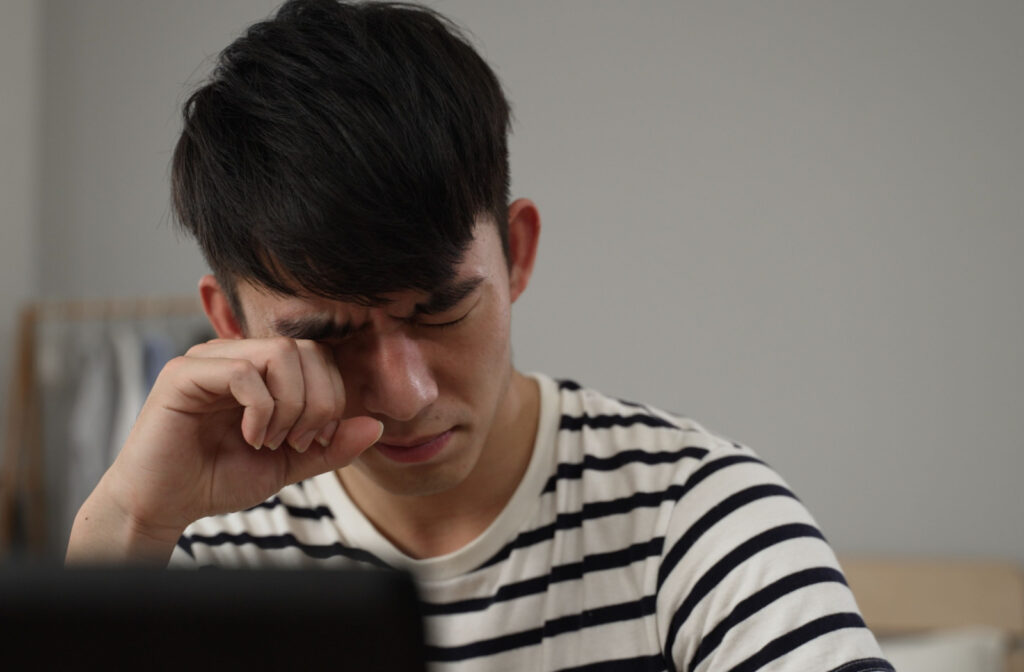In today’s fast-paced digital world, our reliance on electronic devices has increased dramatically. From scrolling through social media to working on a computer all day, it seems like we can’t go a single hour without looking at a screen. Without regular breaks, this constant exposure to screens can take a toll on your eyes.
If you’ve experienced headaches or blurred vision after prolonged device use, it’s likely the result of digital eye strain. The good news is, digital eye strain is usually temporary and typically goes away on its own after taking a break from screen time.
If your symptoms persist even after putting your devices away, it may be evidence of another eye issue, and you should visit your eye doctor for an eye exam.
What Is Eye Strain & How Does It Happen?
Eye strain, also known as digital eye strain or computer vision syndrome, is a common condition that occurs when your eyes are overworked and fatigued from staring at screens for extended periods. This can happen for a number of reasons, such as spending too much time looking at a smartphone, working on a computer all day, or even watching TV.
When you focus your eyes on a screen, your blink rate decreases significantly, which can cause your eyes to dry out and become irritated. Additionally, the blue light emitted from screens may disrupt your sleep pattern and cause eye fatigue. Over time, this constant strain can lead to headaches, blurred vision, and neck and shoulder pain.
Symptoms of Digital Eye Strain
- Eye fatigue or discomfort
- Dry eyes
- Red eyes
- Irritated eyes
- Blurred vision
- Headaches
- Neck pain
- Shoulder pain
If you experience any of these symptoms, it’s a sign to take a break from screen time and let your eyes rest for a moment.
Factors That Can Contribute to Digital Eye Strain
- The distance between your eyes and the screen
- Glare and reflection on the screen
- Incorrect posture while using screens
- Uncorrected vision problems
The Duration of Eye Strain & When to Seek Help
In most cases, digital eye strain is temporary and can be relieved by resting your eyes. However, if you experience persistent symptoms or they worsen over time, it’s important to seek medical attention. This could be a sign of a more serious underlying issue, such as a vision problem.
Additionally, if you have a pre-existing eye condition, such as dry eye or astigmatism, you may be more susceptible to experiencing prolonged digital eye strain. Keep an eye on your symptoms, and if they begin to affect your quality of life, visit your eye doctor for help.
Tips for Relieving Digital Eye Strain at Home
While digital eye strain is usually temporary, it’s still an uncomfortable experience. There are a few things you can do at home to reduce the risk of digital eye strain and make your screen time more comfortable.
Take Regular Breaks from Screens
One of the simplest ways to prevent and alleviate digital eye strain is by taking regular breaks from screens. This allows your eyes to rest and refocus, reducing strain on your eye muscles. Experts suggest following the 20-20-20 rule: every 20 minutes, look at an object that’s 20 feet away for 20 seconds.
Adjust Your Computer Settings
Another helpful tip is to adjust your computer settings. Blue light, which is emitted from electronic devices like computers and phones, has been linked to disrupted sleep patterns. You can use a blue light filter when using your device at night, or simply adjust the brightness and contrast levels on your computer for more comfortable viewing.
Practice Good Posture
Believe it or not, your posture can affect eye strain. Sitting up straight and keeping your screen at eye level will help prevent neck and back pain, which can contribute to eye strain. Make sure to adjust the distance of your screen so that it’s about an arm’s length away from your face.
Use Proper Lighting
Having the proper lighting is crucial when working on screens for extended periods of time. Too much glare or harsh lighting can strain your eyes and cause headaches. Try using a desk lamp with soft, adjustable lighting or positioning yourself near natural light sources.
Consider Using Voice Dictation
If you find yourself typing for long periods, consider using voice dictation software instead. This allows you to give your eyes a break from staring at a screen while still being productive.
Take Breaks & Stretch
It’s essential to take regular breaks throughout the day to give your eyes a rest. Get up and stretch, walk around, or do some quick eye exercises to help keep them relaxed.
Exercises for Tired Eyes
- Palming: Rub your palms together to create warmth, then place them over your closed eyes. Take deep breaths and relax for a few minutes.
- Eye Rolling: Close your eyes and rotate them in a circular motion, first one way and then the other, to help strengthen your eye muscles.
- Blinking: Blink rapidly for a few seconds to lubricate your eyes and reduce dryness.
- Focus Shifting: Look at an object far away for 10–15 seconds, then shift your focus to something close by for another 10–15 seconds. Repeat this exercise a few times to relax your eye muscles.
- Visual scanning: This exercise involves looking from side to side, up and down, and diagonally.
- Figure 8 Eye Movement: Imagine a figure 8 shape in front of you and use your eyes to trace it.
- Pencil push-ups: Hold a pencil at arm’s length and slowly bring it closer to your nose while focusing on its tip. Then, slowly move it away again while maintaining focus. This exercise can help train your eyes to adjust between far and near objects.

Visit an Eye Doctor Regularly
Whether you’re experiencing digital eye strain or some other vision concern, regular visits with an eye doctor are essential. They can check for underlying vision problems that may contribute to eye strain and provide recommendations for proper eye care. Remember, taking care of your eyes is crucial for maintaining good overall health and productivity in the workplace. Here at Danville Optometric Group, we are ready to help with your digital eye strain. Book an appointment today.












